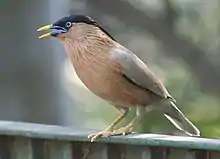| Sturnia | |
|---|---|
 | |
| Brahminy starling (Sturnia pagodarum) | |
| Scientific classification | |
| Domain: | Eukaryota |
| Kingdom: | Animalia |
| Phylum: | Chordata |
| Class: | Aves |
| Order: | Passeriformes |
| Family: | Sturnidae |
| Genus: | Sturnia Lesson, 1837 |
| Type species | |
| Pastor elegans[1] Lesson, 1834 | |
Sturnia is a genus of Asian birds in the starling family Sturnidae. It is sometimes merged with Sturnus.[2]
Taxonomy
The genus Sturnia was introduced in 1837 by the French naturalist René Lesson. He designated the type species as Pastor elegans Lesson, 1834. This is a junior synonym of Oriolus sinensis Gmelin, 1778, the white-shouldered starling.[3][4] The genus name is from Latin sturnus meaning "starling".[5]
The old genus' placement with the starlings was found to be polyphyletic, resulting in changes in the placement. A 2008 study places the following species within this genus:[6]
The genus contains five species:[7]
| Image | Scientific name | Common name | Distribution |
|---|---|---|---|
_-_Weltvogelpark_Walsrode_2013-03.jpg.webp) | Sturnia sinensis | White-shouldered starling | southern China and northern Vietnam |
_Photograph_by_Shantanu_Kuveskar.jpg.webp) | Sturnia malabarica | Chestnut-tailed starling | India and Southeast Asia |
 | Sturnia blythii | Malabar starling | southwest India |
_May_2013_Neil_Island_Andaman.jpg.webp) | Sturnia erythropygia | White-headed starling | Andaman and Nicobar Islands |
_female.jpg.webp) | Sturnia pagodarum | Brahminy starling | Nepal and India, a winter visitor to Sri Lanka |
Former taxonomic treatments have included:
- White-faced starling, Sturnia albofrontata.
- Daurian starling, Sturnia sturnina.
- Chestnut-cheeked starling, Sturnia philippensis.
If the first of these is included, it seems highly warranted to include in Sturnia also the monotypic genera Leucopsar (Bali myna) and Fregilupus (hoopoe starling), and perhaps the enigmatic Necropsar (Rodrigues starling). On the other hand, if these distinct genera are maintained, the white-faced starling would then receive its own genus, Sturnornis.[6]
The other two would better be dealt with by resurrecting Agropsar, either as a distinct genus or as a subgenus of Gracupica, which otherwise includes the black-collared starling ("Sturnus" nigricollis) and pied mynas ("Gracupica sp." ); these four form a robust and ancient group of two sister species that is perhaps even closer to the wattled starling (Creatophpora cinerea) than to the actual genus Sturnus. Their similarity to Sturnia proper is probably simply a symplesiomorphy.[6]
References
- ↑ "Sturnidae". aviansystematics.org. The Trust for Avian Systematics. Retrieved 2023-07-15.
- ↑ Clements, J. (2007). The Clements Checklist of the Birds of the World. 6th edition. Christopher Helm. ISBN 978-0-7136-8695-1
- ↑ Lesson, René (1837). Histoire Naturelle Générale et Particulière des Mammifères et des Oiseaux Décoverts Depuis la Mort de Buffon (in French). Vol. 9, Oiseaux. Paris: Pourrat Frères. p. 53.
- ↑ Dickinson, E.C.; Christidis, L., eds. (2014). The Howard & Moore Complete Checklist of the Birds of the World. Vol. 2: Passerines (4th ed.). Eastbourne, UK: Aves Press. p. 575. ISBN 978-0-9568611-2-2.
- ↑ Jobling, James A. (2010). The Helm Dictionary of Scientific Bird Names. London: Christopher Helm. p. 368. ISBN 978-1-4081-2501-4.
- 1 2 3 Zuccon, D.; Pasquet, E.; Ericson, P.G.P. (2008). "Phylogenetic relationships among Palearctic–Oriental starlings and mynas (genera Sturnus and Acridotheres: Sturnidae)". Zoologica Scripta. 37 (5): 469–481. doi:10.1111/j.1463-6409.2008.00339.x.
- ↑ Gill, Frank; Donsker, David; Rasmussen, Pamela, eds. (July 2023). "Nuthatches, Wallcreeper, treecreepers, mockingbirds, starlings, oxpeckers". IOC World Bird List Version 13.2. International Ornithologists' Union. Retrieved 13 August 2023.